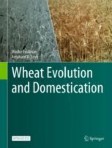Search
Search Results
-
Population Genomic Analysis of Diploid-Autopolyploid Species
This chapter outlines an empirical analysis of genome-wide single-nucleotide polymorphism (SNP) variation and its underlying drivers among multiple...
-
Evolution of the Diploid Species of the Sub-tribe Triticineae
Based on the phylogenetic relationships, the diploid species of the sub-tribe Triticineae are classified in five clades. The phylogenetic...
-
Oat species and interspecific amphiploids show predominance of diploid nuclei in the syncytial endosperm
Apart from apomictic types, the Polygonum- type eight-nuclear embryo sac is considered to be dominant in grasses. A triploid endosperm is formed as a...

-
Conserved and divergent evolution of the bZIP transcription factor in five diploid Gossypium species
Main conclusion495 bZIP members with 12 subfamilies were identified in the five diploid cottons. Segmental duplication events in cotton ancestor...

-
Basis of Karnal bunt resistance in diploid and tetraploid Triticeae species
Karnal bunt (KB) is one of the most important post-harvest disease of wheat. Although the extent of damage caused by KB is low in terms of grain...

-
Enhancing microspore embryogenesis in diploid potato (Solanum tuberosum L. ssp. tuberosum) germplasm
Doubled haploidy (DH) technology has been utilized in cultivated tetraploid potato ( Solanum tuberosum L. ssp. tuberosum ) to accelerate crop...

-
Comparative repeatome analysis reveals new evidence on genome evolution in wild diploid Arachis (Fabaceae) species
Main conclusionOpposing changes in the abundance of satellite DNA and long terminal repeat (LTR) retroelements are the main contributors to the...

-
Constructing telomere-to-telomere diploid genome by polishing haploid nanopore-based assembly
Draft genomes generated from Oxford Nanopore Technologies (ONT) long reads are known to have a higher error rate. Although existing genome polishers...

-
Three near-complete genome assemblies reveal substantial centromere dynamics from diploid to tetraploid in Brachypodium genus
BackgroundCentromeres are critical for maintaining genomic stability in eukaryotes, and their turnover shapes genome architectures and drives...

-
Behavior of chromosomes from the Mexican wild diploid species Solanum pinnatisectum in the interspecific hybrid with cultivated potato and its backcross progenies
The genomic relationship between Mexican wild diploid species and South American wild and cultivated potato species is ambiguous because these...

-
The diploid number decrease in cardinalfishes (Apogonidae, Kurtiformes): chromosomal rearrangements and related biological features
Cardinalfishes are a diverse family of small fish found in reef habitats. Some species exhibit bioluminescence and unusual characteristics of buccal...

-
Diploid Interspecific Recombinant Inbred Lines for Genetic Map** in Potato
Recombinant inbred line (RIL) populations are powerful map** tools in many crops but have not yet been created using cultivated potato germplasm....

-
Comparative analysis of molecular and morphological diversity in two diploid Paspalum species (Poaceae) with contrasting mating systems
Key MessageInterspecific comparison of two Paspalum species has demonstrated that mating systems (selfing and outcrossing) contribute to variation...

-
Comparative analysis of SIMILAR to RCD ONE (SRO) family from tetraploid cotton species and their diploid progenitors depict their significance in cotton growth and development
BackgroundSRO (Similar to RCD1) genes family is largely recognized for their importance in the growth, development, and in responding to...

-
Cytological analysis of the diploid-like inheritance of newly synthesized allotetraploid wheat
Polyploidization is a process which is related to species hybridization and whole genome duplication. It is widespread among angiosperm evolution and...

-
Diploid Potatoes as a Catalyst for Change in the Potato Industry
In response to increasing interest in diploid potato ( Solanum tuberosum ) breeding and the production of diploid inbred hybrid potato varieties, the...

-
Can the Ovum Genome of Tetraploid Sturgeon Species (Acipenseridae) Exhibit the Functional Properties of a Diploid Genome?
AbstractViable prelarvae were obtained for the first time as a result of insemination of eggs of the kaluga Acipenser dauricus with UV-inactivated...

-
Identification of new genetic sources of resistance to bacterial blight race 18 in diploid Asiatic cotton and resistance transfer to tetraploid Upland cotton (Gossypium hirsutum)
Bacterial blight (BB) caused by Xanthomonas citri pv. malvacearum (Xcm), poses a significant threat to Upland cotton ( Gossypium hirsutum L.)...

-
Effects of temperature on broodstock conditions, gonadal development and survival of tetraploid and diploid oysters of ‘Haida No. 3’ line (Crassostrea gigas)
Tetraploid oysters are valuable germplasm resources for the production of triploid oysters. However, the broodstock condition and gonadal development...

-
CRISPR/Cas9-mediated genome editing in diploid and tetraploid potatoes
CRISPR/Cas9 is a unique technology that has enabled researchers to edit genomes. The current study was conducted to investigate the efficiency of...

